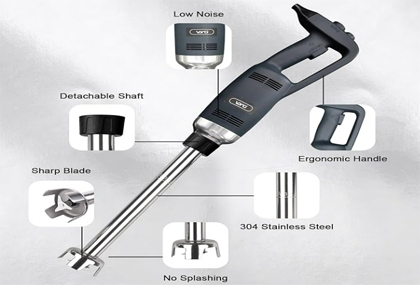What's the Difference Between an Automatic Blender and a Manual Blender?
Nov 29,2024
499
In today's era of increasingly abundant kitchen appliances, blenders have become common tools in many households and professional kitchens. Among them, automatic blenders and manual blenders are choices that people often face. So, what exactly are the differences between them?

I. Working Principle
Automatic Blender
The automatic blender is mainly powered by electricity. It is usually equipped with a powerful motor that can operate at a high speed and with stable power.
Users only need to put the ingredients into the mixing container, select the appropriate mixing mode and speed, and the machine will automatically complete the mixing work. For example, some automatic blenders can set different mixing times and speeds to meet the mixing needs of different ingredients, easily handling tasks from mixing batter to making fruit juices and smoothies.
The mixing process of the automatic blender is relatively standardized and precise, ensuring that the mixing effect is basically the same each time.
Manual Blender
The manual blender relies entirely on manual operation. It usually consists of a mixing rod and a handle. Users rotate the handle manually to drive the mixing rod to rotate, thus achieving the purpose of mixing ingredients.
The mixing speed and intensity of the manual blender are completely controlled by the user and can be adjusted at any time according to the actual situation. But this also means that the mixing effect may vary depending on the user's operating skills and physical strength.
II. Convenience of Use
Automatic Blender
Automatic blenders are very convenient to use. Just plug in the power, press the corresponding button or set the parameters, and then wait for the mixing to be completed. It doesn't require much physical effort, especially suitable for those who need to mix a large amount of ingredients frequently or people with weak physical strength.
Some high-end automatic blenders also have intelligent functions such as automatic cleaning and overheat protection, further improving the convenience and safety of use.
However, automatic blenders are usually large in size and require a certain amount of space to place. Moreover, after use, they need to be cleaned and maintained, which is relatively troublesome.
Manual Blender
The advantage of the manual blender lies in its small size and light weight, which is easy to carry and store. It can be used anywhere without being restricted by power supply, very suitable for occasions such as outdoor picnics and camping.
The operation of the manual blender is also very simple. It doesn't require complex settings and operation processes, and even people without any kitchen experience can easily get started.
However, the manual blender requires manual operation. For some situations that require long-term mixing or mixing hard ingredients, it may be relatively laborious, and the mixing efficiency is relatively low.
III. Mixing Effect
Automatic Blender
Due to the large motor power of the automatic blender, the mixing speed is fast and stable, and it can mix the ingredients very finely and evenly. For example, when making cake batter, the automatic blender can fully mix ingredients such as flour, eggs, and butter, making the texture of the batter smoother and thus ensuring the taste of the cake.
Automatic blenders can also choose different mixing attachments such as egg beaters and mixing paddles according to different ingredients and mixing needs, further improving the mixing effect.
Manual Blender
The mixing effect of the manual blender depends on the user's operating skills and physical strength. Generally speaking, the manual blender can mix relatively soft ingredients such as fruits and vegetables relatively evenly, but for harder ingredients or situations that require very fine mixing, it may be powerless.
The mixing speed of the manual blender is relatively slow, which may cause the ingredients to be heated unevenly during the mixing process and affect the mixing effect.
IV. Price
Automatic Blender
Automatic blenders are usually more expensive. This is because it is equipped with complex components such as motors and control systems, and the production process and technical requirements are also relatively high. Generally speaking, brand-name and better-functioning automatic blenders may cost several hundred yuan or even more than a thousand yuan.
However, from the perspective of long-term use, the performance and convenience of automatic blenders may make them have higher cost performance.
Manual Blender
The price of manual blenders is relatively low. Due to its simple structure and low production cost, the price is usually between tens of yuan and more than one hundred yuan.
For some people with limited budgets or those who only need to mix ingredients occasionally, the manual blender is a good choice.
In conclusion, automatic blenders and manual blenders each have their own advantages and disadvantages. Automatic blenders have the advantages of convenient use and good mixing effect, but they are relatively expensive and large in size; manual blenders are small, light, and inexpensive, but their mixing efficiency and effect are relatively low. When choosing, users can consider their actual needs and budgets. If you need to mix a large amount of ingredients frequently or pursue an efficient and convenient mixing experience, then an automatic blender may be a better choice; if you only need to mix ingredients occasionally or pay attention to portability and economy, then a manual blender is more suitable.





